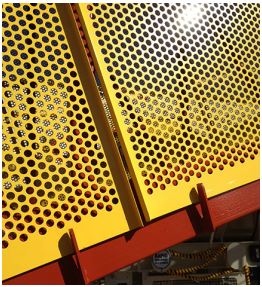Expanded Metal vs. Perforated Metal
Comments Off on Expanded Metal vs. Perforated MetalBoth expanded metal and perforated metal are suitable for use in ventilation or drainage applications.
Additionally, their integration of geometric patterns, makes both a popular aesthetic element added to various fixtures and structures.
Despite their similarities in function, these two metals are distinct; they require the use of different manufacturing methods, exhibit different characteristics, and have different best use cases. Understanding the differences between them is critical when selecting one or the other for an application.
In the following blog post, we provide an overview of how perforated and expanded metal differ, outlining how they’re manufactured, key characteristics, and ideal applications.
All About Expanded Metal
 For ventilation and drainage products, expanded metal is a strong and cost-effective option.
For ventilation and drainage products, expanded metal is a strong and cost-effective option.Manufacturing Method for Expanded Metal
The key to expanded metal’s strength is in its manufacturing process. The first step is to perforate the sheet with a series of regular slits. Stretching the sheet after adding these openings creates the distinctive, repeating diamond pattern that distinguishes expanded metal from other material options. After the stretching process, some strands of metal may protrude slightly, but it’s possible to flatten these later on if necessary or desired.
There are two key advantages to this technique:
- It decreases the amount of material waste produced—therefore increasing material utilization—which translates to lower production costs.
- It creates materials with greater structural strength than that of materials with holes punched directly into them (i.e., perforated metal).
Key Characteristics of Expanded Metal
As indicated above, expanded metal retains its structural integrity better than perforated metal. In addition to this property, other key characteristics include low risk of unraveling (compared to woven mesh) and excellent conductivity.
Ideal Applications for Expanded Metal
When choosing to use expanded metal for an application, some of the key considerations include thickness and strand dimension, both of which depend on the structure’s requirements. It is available in a wide range of materials, mesh sizes (including near-transparent thickness), and pattern designs to suit different use cases.
Some of the most common applications for which expanded metal is ideal include:
- Airbags
- Animal Flooring
- Architectural components
- Automotive racks
- Car grilles
- Automotive racks
- Ceiling panels
- Chimney caps
- Ceiling panels
- Lockers
- Machine guards
- Screening
- Screening
- Speaker grilles
- Trailer flooring
- Vents
- Waste receptacles
All About Perforated Metal

Perforated metal is the preferred choice for use in certain applications such as filtration equipment.
Manufacturing Method for Perforated Metal
Like expanded metal, perforated metal begins as a steel sheet. However, rather than slicing and stretching the sheet, a technician feeds the base material into a specialized machine that punches holes in a pre-defined pattern (typically either straight or staggered lines of holes). The machine usually leaves a thin section of metal around the perimeter unpunched to avoid compromising the material’s stability.
The perforation process does, by necessity, generate waste. While the excess metal can be recycled, doing so may increase the overall project cost. Manufacturing sheets with larger holes produces more material waste—resulting in higher production costs—so customers with such requirements should consider if expanded metal is a better fit for their budget.
Key Characteristics of Perforated Metal
Compared to expanded metal, perforated metal’s main advantage is its versatility. It is available in a broad selection of variations, with different material, hole gauge, hole size, and hole shape options.
Ideal Applications for Perforated Metal
As perforated metal is available in many different variants, it lends itself to use in a wide range of applications. Some examples include the following, although perforated metal applications are by no means limited to this list:
- Acoustical enclosures
- Architectural structures
- Electronic enclosures
- Farm equipment
- Filtration
- Grain dryers
- Home appliances
- HVAC equipment
- Lighting fixtures
- Pharmaceutical systems
- Speaker grilles
- Store displays and fixtures
Expanded and Perforated Metal Solutions From Metalex
At Metalex, we recognize the value of both expanded metal and perforated metal. As such, we maintain a broad selection of perforated metal materials and expanded metal products for our customers. Whichever material you need, our expert sales and engineering team will ensure you get the right product for your application and requirements.
For additional information about our offerings or assistance choosing one for your next project, contact us or request a quote today.
Considerations When Selecting Perforated Products
Comments Off on Considerations When Selecting Perforated ProductsThe process of perforation creates perforated materials, which are substrates—such as papers, plastics, composites, and metals—with a series of holes of varying shape and size. In addition to variation in hole design and pattern, these products are available in a wide range of sizes, thicknesses, and forms (e.g., coils).
While this seemingly endless selection of perforated product options can seem daunting, there are a few key considerations to keep in mind when choosing one for your application. The following article outlines some of the typical applications of perforated metals and critical factors to consider during the selection process.
Applications of Perforated Materials
Perforated materials find use throughout industry in a variety of applications. For example, they are used in:
- Acoustical enclosures to protect internal equipment from contaminants and absorb specific frequencies
- Architectural elements to add structural strength and aesthetic value
- Filtration equipment to separate dust and other contaminants
- HVAC equipment to facilitate even air distribution, reduce noise, and add aesthetic value
- Lighting fixtures to prevent damage to internal components while letting out light and, in some cases, create unique lighting patterns
Other applications for perforated materials include:
- Electronic enclosures
- Farm equipment
- Grain dryers
- Home appliances
- Pharmaceuticals
- Store displays and fixtures
Selection Considerations for Perforated Materials
There are several key factors to consider when choosing a perforated material, such as:
Application
The intended application of your end product is the primary consideration when selecting a perforated material. Knowing what the product needs to do and how it should operate significantly influences other decision-making factors.
Material
Perforated materials are available in a number of base substrates, each offering its own set of properties that make it suitable for use in specific applications. Although options vary depending on the supplier, some of the most common materials include:
- Steel (e.g., hot-rolled pickled, cold-rolled, galvanized, aluminized, and pre-painted)
- Aluminum (e.g., 3003 H14, 5052 H32, and protective film-coated)
- Stainless steel (e.g., protective film-coated, 400-series, T304, and T316)
- Brass (1/2 hard)
- Copper (e.g., C11)
- Special alloys (e.g., Inconel, copper-nickel, titanium, corten, and Muntz)
- Plastics (e.g., PVC, polypropylene, ABS, Kydex, Mylar, and PTFE)
Hole Size, Center, and Shape
Perforated materials are available with a variety of hole shapes and sizes. The size and spacing of the holes and the hardness and thickness of the base material affect the rate and cost of production. For example, production operations involving perforated materials with round and larger holes generally require less production time and have faster production rates, while those involving materials with thicknesses similar to the punch diameter or bar tend to have lower production rates and cost efficiency.
Perforation Patterns
In addition to size and shape, you must also select the pattern of holes on your perforated material. The 60-degree stagger is widely considered to be the strongest and most economical round hole pattern and the industry standard.
Other holes patterns include:
- Straight and diagonal (45 degrees): less common but available in a range of standard hole sizes
- Square and slot: available in straight, side, and end stagger configurations
- Decorative patterns: unique designs tailored to specific applications
Additional Considerations
Other factors to keep in mind when selecting a perforated material include:
- Open area
- Holes per square inch
- Margins
- Finished end pattern
- Sheet or coil size
- Special finishes
- Additional processing requirements
- Quality requirements
Contact Metalex Today
At Metalex, Powered by UPG, we understand that our customers’ needs are constantly changing. To meet these ever-evolving needs, we are continually adding to our selection of high-quality perforated materials.
Our perforated metal products are highly versatile, finding practical application across a range of industries. Equipped with a team of engineers and technical experts, state-of-the-art equipment, and customizable tools, we have the power to tailor solutions to our customers’ applications.
To provide cost-effective and reliable perforated metal solutions, we arm our team with the knowledge on how to choose the right perforated material. To learn more about choosing the right perforated product to meet the form, fit, and function of your project, download our eBook “Proper Selection for Perforated Products”.
Metal Solutions for the Architectural Industry
Comments Off on Metal Solutions for the Architectural Industry Metals have many inherent qualities, including strength, malleability, and durability, that make them ideal building components. Recently, architects and contractors have begun adopting new metal solutions to improve building performance, aesthetics, and safety. Two of the most common techniques, perforated and expanded metal, are particularly prized for their high strength, reliability, and flexibility, and their ability to provide high levels of security make them particularly beneficial for new or rehabbed buildings.
Metals have many inherent qualities, including strength, malleability, and durability, that make them ideal building components. Recently, architects and contractors have begun adopting new metal solutions to improve building performance, aesthetics, and safety. Two of the most common techniques, perforated and expanded metal, are particularly prized for their high strength, reliability, and flexibility, and their ability to provide high levels of security make them particularly beneficial for new or rehabbed buildings.Below, we’ve outlined some of the main uses of perforated and expanded metals, as well as some qualitative benefits they’ll bring to your next construction project.
Metal Solutions
Perforated and expanded metals can form a variety of innovative products, composites, and sustainable design solutions that will perform well across a range of climates and building types. Here are some of these metals’ most common applications:
Ceiling Ducts
Perforated metals evenly distribute air in ceiling ducts and reduce excessive noise typical to HVAC systems. Many companies provide a wide selection of architectural perforated metal products to be considered for each construction project.
 Security Mesh inside Walls, Ceilings, and Floors
Security Mesh inside Walls, Ceilings, and FloorsBarrier and security fence manufacturers use expanded metals to create meshes for use on walls, ceilings, or floors. Because of their inherent strength, expanded metal barrier meshes can protect against break-ins and break-outs, ensuring the safety of facilities and the people using them.
Stairs, Railings, and Arches
High-performance metals allow for complex, intricate designs in stairs, railings, and arches while meeting safety and durability requirements. By incorporating metal solutions into their plans, architects can design more creative and competitive solutions and incorporate delicacy into their design without sacrificing function.
Siding and Roofing
Because of their malleability, you can easily form perforated and expanded metals into a variety of shapes. Consequently, using these metals for your roofing or siding can be an extremely affordable, versatile, and effective solution, especially in high–wind uplift conditions.
Other Uses
Expanded and perforated metals also work well in architectural fencing, facades, lighting, doors, gates, lockers, office dividers, privacy screens, sunshades, sunscreens, windows, and skylight guards.
Benefits of Metal Solutions in Architecture
 Making use of innovative new metal solutions allows for trade collaboration in the architectural industry. The large range of customization capabilities for perforated and expanded metals allows for a great deal of collaboration to take place between suppliers and clients. Because these metals can come in so many shapes, forms, and abilities, they offer limitless possibilities.
Making use of innovative new metal solutions allows for trade collaboration in the architectural industry. The large range of customization capabilities for perforated and expanded metals allows for a great deal of collaboration to take place between suppliers and clients. Because these metals can come in so many shapes, forms, and abilities, they offer limitless possibilities.High-performance materials such as expanded and perforated metals also boost your buildings’ integrity and longevity. Their ability to easily form and conform to new applications enables these metals to provide solutions to previously hard-to-solve problems.
Finally, implementing new metal-forming techniques helps architects meet or exceed building code requirements for complex issues such as water penetration, uplift ratings, fire protection, and seismic and structural performance.
Use Perforated and Expanded Metals in Your Next Construction Project
New metal-forming techniques are taking the market by storm. Adopting perforated and expanded metals for your next architectural project will provide the same degree of security and metal coverage as other techniques, but will consume fewer resources while doing so
Perforated Metal in Architectural Design
Comments Off on Perforated Metal in Architectural DesignValued for its strength, flexibility, and aesthetics, perforated metal is a popular material choice for commercial and residential architectural applications alike. Most often, perforated metal — also called perforated sheet, perforated plate, or perforated screen — is used for facades and exterior building design. But it’s also used in a huge range of other applications, from food and furniture to automotive and agriculture.
To produce this unique metal, a raw material is coil-fed into a high-speed press. The metal is punched on the downstroke of the press, and the material advances on the upstroke of the press. The size, shape, and pattern of the perforations are custom-made, and will depend on the specific project and aesthetic requirements at hand. Few materials can achieve both the flair and functionality afforded by perforated sheet metal.
Perforated Metal Form and Function
 Perforated sheets can be made from a variety of materials — stainless steel, coated steel, refractory metals, aluminum, copper alloys, zinc, nickel, and titanium, just to name a few — in order to work in conjunction with materials such as wood, natural stone, ceramic tiles, bricks, glass, and leather. This unique metal can also be manufactured in many different styles and patterns. Holes in the metal sheet can be round, diamond, hexagonal, or square, and are offered in various sizes. These holes can be arranged in a staggered or straight pattern.
Perforated sheets can be made from a variety of materials — stainless steel, coated steel, refractory metals, aluminum, copper alloys, zinc, nickel, and titanium, just to name a few — in order to work in conjunction with materials such as wood, natural stone, ceramic tiles, bricks, glass, and leather. This unique metal can also be manufactured in many different styles and patterns. Holes in the metal sheet can be round, diamond, hexagonal, or square, and are offered in various sizes. These holes can be arranged in a staggered or straight pattern.Perforated metal is very easy to clean and maintain, making it well-suited to both indoor and outdoor architectural design applications. It’s commonly used in facades, stair railings, balconies, ceilings, room dividers, stairways, and screens.
The Benefits of Perforated Metal
Perforated metal offers several key advantages, including:
Optimal aesthetics — There are countless customization options available for perforated metal products. Hole shapes, sizes, geometric patterns, and finishes can all be chosen to match the particular application at hand, making it easy to achieve a specific look.
High versatility — Because perforated metal can be easily bent and configured to suit its intended application, it’s ideal for use as a lightweight decorative element or as a structural component in buildings.
Sound absorption — Perforated metal is an excellent material for diffusing sound. For example, it can play a key role in eliminating frequencies in sound-filtering systems, such as enclosures surrounding large air-conditioning or compressor units.
Superior ventilation — The openings in perforated metal permit the passage of light, air, heat, and gases. And by allowing for a balanced level of natural lighting during the day, perforated metal reduces the amount of artificial light needed, while deflecting heat at the same time. Adding visual interest to buildings’ exterior, perforated metal allows occupants to enjoy views while still maintaining privacy.
Durability — Thanks to its high strength-to-weight ratio, perforated metal can also control or equalize pressure, allowing it to easily withstand harsh weather. Plus, the perforations reduce the material’s overall weight, meaning buildings’ frameworks have less to support.
Perforated Metal for Your Design
To learn more about perforated metal or discuss options for your next architectural design project, contact the experts at Metalex today.
What Factors Should You Consider for Your Speaker Grille’s Design?
Comments Off on What Factors Should You Consider for Your Speaker Grille’s Design?Extensive design and engineering is involved in the manufacturing of a speaker grille to protect and support the sound quality of the speaker.
That’s why Early Supplier Involvement (ESI) is critical for speaker grille applications. ESI provides better collaboration between the manufacturer and the supplier to deliver better quality, lower costs, and faster development.
Metalex has over 50 years’ experience in the expanded and perforated metal industry. Our team of talented engineers and range of operation capabilities offer the audio industry a one-stop shop for their speaker grille design.
Our team collaborates to ensure that the pattern and material chosen are ideal for the aesthetic and functional requirements of the design. Metalex is the ideal partner for speaker manufacturers.
 Speaker Grilles
Speaker GrillesSpeaker grilles are protective measures critical to the home, automotive and professional audio industries. Speaker grilles are designed to protect the inner workings of a speaker — the cone, tube, and delicate electronics behind them, without distorting the sound quality.
With careful consideration throughout the design and manufacturing process, you can achieve an appropriate balance of protection and sound quality.
Material
While a harder protective element can provide stronger protection, a speaker grille material that is too hard won’t flex with the sound waves. The lack of flexibility in the grille can actually damage a speaker, instead of protecting it from damage as intended.
Choosing a material of the appropriate density achieves both protection for the components and flexibility for sound production.
Perforations
Speaker grilles have perforations by necessity — sound vibrations must be able to travel from the speaker tone to the listener. A solid sheet of metal, even a very thin one, would drastically impact sound quality. A quality speaker grille design incorporates a high percentage of open area through the pattern of perforation and bar size to achieve unaltered sound, while providing protection for the inner workings of the speaker.
 Grille Design & Manufacture with Metalex
Grille Design & Manufacture with MetalexLearn about more factors to consider in the design and manufacture of speaker grilles – download our free eBook, “Early Supplier Involvement in Speaker Grilles.”
Uses for Engineered Metal in Architectural Design
Comments Off on Uses for Engineered Metal in Architectural DesignEngineered metal is a key element in many architectural projects.
Metalex engineers work with architects and designers to develop the appropriate pattern and style to meet the demands of almost any project. Our coil-fed processing and breadth of manufacturing capabilities allow us to efficiently produce safety grating, security fencing, sunshades, facades, and ceiling panels for architectural applications.
There are an astounding range of applications for converted sheet metal. From the most utilitarian functional walkway to an artistic accent, the possibilities are endless.
Perforated Metal
 Perforated metal is produced when a raw material is coil-fed into one of our high speed presses. The metal is punched on the downstroke of the press and the material advances on the upstroke of the press. The size, shape, and pattern of perforations are manufactured according to your needs and precise aesthetic purpose.
Perforated metal is produced when a raw material is coil-fed into one of our high speed presses. The metal is punched on the downstroke of the press and the material advances on the upstroke of the press. The size, shape, and pattern of perforations are manufactured according to your needs and precise aesthetic purpose.Strokes can be skipped in order to create gaps or margins perpendicularly across the material, and sections of punches can be gagged to create a parallel center margin or rectangular element of un-punched space within the pattern.
Safety Grating
Safety grating is produced when a raw material is coil-fed into a heavy duty die press.
However, safety grating is produced exclusively in a coil-to-sheet process: a coil feeds the machine and a cut to be made at a set length upon exiting the press. Metalex offers a unique programmable die which allows for sections of the pattern to be gaged and angles or unique shapes to go punctured through the press.
Expanded Metal
Expanded metal is produced through a coil-fed process in which raw material is simultaneously slit and stretched creating uniform diamond-shaped openings. Expanded metal can be recoiled or blanked into sheets depending on the desired end use. Metalex offers inline flattening and inline slitting on our expanded metal production lines.
Learn More
Metalex’s expertise on engineered metal for architecture was recently in Engineering.com. Read the article for more information.
Unique Uses for Perforated Metal
Comments Off on Unique Uses for Perforated Metal A simple sheet of perforated metal can serve many architectural functions in an effective and cost-efficient manner. Perforated metal is used in everything from acoustical applications, outdoor furniture, balustrades, and many more. Once you know where to look, you’ll find that perforated metal is a commonplace element in the construction and development of entire buildings. Consider using perforated metal for the following, key architectural applications in your next building design.
A simple sheet of perforated metal can serve many architectural functions in an effective and cost-efficient manner. Perforated metal is used in everything from acoustical applications, outdoor furniture, balustrades, and many more. Once you know where to look, you’ll find that perforated metal is a commonplace element in the construction and development of entire buildings. Consider using perforated metal for the following, key architectural applications in your next building design.In acoustical applications, perforated metal can be utilized in two different ways. It can serve as a facing for acoustic material, or as a part of a tuned resonant absorber. In the first example, a perforated metal sheet is positioned over a sound-absorbing, or sound-reflecting, material and is used as a protective or decorative covering. In the second case, the panel is designed with a specific thickness and number of holes to remove sounds in a certain range of frequencies.
Perforated metal is commonly used to build outdoor furniture, such as benches, picnic tables and garbage cans. Aesthetically, perforated metal has a modern appeal and does not visually obscure surrounding scenery. Practically, the perforations allow rain and fine debris to drain away, rather than collect on the surface. Perforated metal is durable, so it can endure harsh environmental conditions and strong winds. Unlike wood, moreover, it does not require yearly maintenance to prevent warping.
Many building façades and staircases are also built from perforated metal. As a façade, perforated metal is an efficient sun protection system. The metal delivers UV protection while permitting light and air to filter through. Like perforated metal furniture, staircases built from this material are ideal for outdoor use because they allow rainwater to drain away. This is especially desirable from a safety perspective, as puddles of water can cause people to slip and injure themselves.
Perforated metal panels provide an ideal ventilation filter for HVAC systems. The gauge, size, and hole pattern of a perforated metal vent will vary based on the specific application. However, a properly designed vent will enhance the efficiency of any heating, ventilation or air conditioning system. Perforated metal vents distribute air evenly for uniform room temperatures, reduce noise pollution from fans by breaking up airflow, and conceal filtered media in a visually pleasing container.
Suspended ceilings made from perforated metal are available in a variety of designs, textures, and colors. In addition to its decorative appeal, these panels are easy to install, provide sound-proofing benefits, and conveniently cover unsightly ducts and pipes without restricting access for regular maintenance. Lightweight and durable, suspended ceilings made of perforated metal are commonly installed in commercial buildings and residential homes to add value to an interior space.
Perforated metal panels are also used to make eye-catching and durable balustrades. Designer balustrades made of corrosion-resistant perforated metal improve the safety of balconies and stairwells. They also provide some degree of privacy while allowing sunlight and air to pass through. Just as with perforated metal suspended ceilings, these balustrades come in a range of beautiful designs and colors to suit the aesthetic of any building or home.
As the examples above suggest, there are a myriad of uses for perforated metal in the architectural space. Perforated metal is not only practical, but also visually appealing. It can be used to shield everything from the sun’s harsh rays in an office building, to dust and debris in an HVAC system. It can be an elegant design solution for the home, and a durable material for outdoor and recreational spaces. For more information about perforated metal for your specific project, please contact the experts at Metalex today.
Selecting the Right Perforated Tubes
Comments Off on Selecting the Right Perforated TubesWhat Are Perforated Tubes and How Do You Select the Right Ones?
Perforated tubes are metal tubes that have holes or slits punctured through the wall to enable liquids or air to enter or exit the cylinder. Filter applications such as oil filtration are the most common use of perforated tubes, although they are also frequently utilized for underground drainage. Additionally, vehicle mufflers commonly employ perforated tubes when needing to reduce engine sounds and filter exhaust gases.
Architectural Applications for Perforated Tubes
Due to their practical and aesthetic features, perforated metal tubes are very popular among architects and designers. That’s why you’ll find them being used in lighting fixtures, conduit ducts, safety guards, and other interior design elements, in which they allow light or air to be exchanged or to dampen sound or noise.
Choosing Perforated Metal Tubes for Your Application
Perforated tubes come in a variety of patterns, styles in the perforations, and seams of the tubing. Metalex offers two primary seam designs for perforated spiral tubes: the flush (outside) and inside lock seam, which is popular for use in fluid filtration; we also offer a unique spiral louvered design with a flushed lock seam, used as an alternative to the straight seam tube when a weld is not required. Other seam designs include various welded and abutted options.
Perforated tubes come in a variety of materials to meet the requirements of the specific application. Materials used in the manufacture of perforated tubing include: tin plated, galvanized metal, stainless steel, brass, and aluminum. The material used will be application-specific based on the demands of the environment or the aesthetics required.
For example, perforated tin plated metal tubes are used primarily in filtration type applications. While perforated stainless steel, brass, and aluminum tubes lend themselves to use as architectural elements.
When selecting a type of perforated tubing for a particular application, our customer service representatives are available for commercial advice. To learn more about our perforated products, access your copy of our guide Proper Selection for Perforated Products by clicking here or the button below.
Save Costs by Choosing Perforated Sheet Metal Stock Pieces
Comments Off on Save Costs by Choosing Perforated Sheet Metal Stock PiecesIn general, the best way to minimize cost when utilizing perforated metal in a project is to choose readily available (stock) pieces, or those that can be created easily with standard tooling. Going custom usually means that the cost will escalate rapidly.
The table below provides a quick summary of the key characteristics of perforated metal and the cost considerations associated with each. Keeping your specification within these margins will result in a cost-effective approach to procuring your pieces.
Characteristics
Cost Considerations
Material Type Balance material type and strength against required sheet thickness to determine the most cost-effective metal for the project Sheet Size Choose a standard size sheet:· 3’x8’ · 4’x8’
· 3’x10’
· 4’x10’
Thickness · Thinner sheets are less expensive· Balance strength requirements against thickness to maximize cost effectiveness Hole Shape · Round holes are the most common and cheapest hole shape – readily available in stock pieces· Square and slot hole shapes are also available in stock pieces, although in limited configurations Hole Pattern · Straight line and staggered layouts are available in stock pieces· 60° staggered is the most common layout due to clean appearance and high strength of the staggered patterns. · 45° pattern also available
Hole size · For low strength materials make sure that the hole size measurement is equal to or greater than the thickness of the metal· High-strength material and stainless steel, choose a hole size that is approximately 3 times the metal thickness Bar Width · Standard bar width range from 3/32 of an inch to 1 ¼ inch· Bar width should be equal to or greater than the thickness of the sheet · Select maximum acceptable bar width — greater spacing between rows speed up production time and lowers cost
Center Distance Increase center to center distance to the maximum possible to speed up production time Open Areas Maintain percent open area in values of 70% or below in order to minimize distortion in the perforated metal Margins · When possible use standard margins· Unfinished ends are industry-standard and readily available · Maintain margins at a distance that minimizes distortion of metal
Blank Areas Incorporate blank areas in the perforated metal sheets as a substitute for expensive joining or welding operations Burrs Accept standard expected burr heights from perforating process unless ultra-flat sheets are needed for special applications Know Your Options When Selecting Perforated Products
There are many factors that go into selecting the right thickness, hole size, hole shape, spacing and more for perforated products. Our eBook, Proper Selection for Perforated Products, shares the cost implications and applications for different sizes and types of perforated sheets.
Choosing the Right Hole Shape & Pattern for Your Perforated Product
Comments Off on Choosing the Right Hole Shape & Pattern for Your Perforated ProductPerforated tubes and other perforated products are widely used in a myriad of filtration, dampening, exhaust, drainage, and other industrial applications. Holes contained within perforated products are created using a combination of standard and/or custom punches, CNC punching pattern software, and special fabrication techniques. The size of the holes in the perforated tube or other product is typically determined by the application—for example, by the size of contaminants the tube must filter out.
Architectural Applications for Perforated Products
Due to their wide range of practical and aesthetic features, perforated metal is popular among architects and designers. You’ll find them being used in an array of applications, including:
- Lighting fixtures
- Conduit ducts
- Safety guards
Perforated metal is common as interior design elements, in which they allow light or air to be exchanged. They may also be used to dampen unwanted noise.
Choosing Perforated Metal Tubes for Your Application
Perforated tubes come in many different patterns. Ultimately, the design and application requirements will determine the perforation styles, or if the seams of the tubing contain perforations.
Metalex offers two primary seam designs for perforated spiral tubes: the flush (outside) and inside lock seam, which are popular for use in fluid filtration. We also offer a unique spiral louvered design with a flushed lock seam, used as an alternative to the straight seam tube when a weld is not required. Other seam designs include various welded and abutted options.
Perforated tubes come in an assortment of materials to meet the requirements of the specific application. Materials used in the manufacture of perforated tubing include:
- Tin plated
- Galvanized metal
- Stainless steel
- Brass
- Aluminum
The material will be application-specific based on the demands of the environment or the aesthetics required. For example, perforated tin plated metal tubes are common in filtration type applications, while perforated stainless steel, brass, and aluminum tubes are used as architectural elements.
Shapes
The types of hole shapes available in perforated products are limited only by the ability to machine cutting dies into a specific configuration that can create the shape and withstand the stresses of the punching process. Below are the most commonly used and most cost effective hole shapes:
 Round Holes. A round hole is the easiest and most economical shape to incorporate into perforated sheet metal, as the relative simplicity of machining a round piece results in low manufacturing costs. Round hole patterns are used in a variety of applications, including air-conditioning and heating systems and decorative finishes for architectural installations.
Round Holes. A round hole is the easiest and most economical shape to incorporate into perforated sheet metal, as the relative simplicity of machining a round piece results in low manufacturing costs. Round hole patterns are used in a variety of applications, including air-conditioning and heating systems and decorative finishes for architectural installations.
- Square Holes. Square holes provide a significant amount of open area and a clear view through finished sheets, while also offering a strong barrier that can be used to resist impact loads, prevent contact with equipment, or prevent entry of trespassers into protected areas. Increased wear on equipment occurs during the square hole perforation process due to the tendency of the punches to experience increased stresses near the corners of each square shape. For this reason, the creation of square hole patterns has increased costs over the production of round holes.
- Slot Holes. Slot holes consist of long rectangles with half-circle or square ends. These are versatile shapes in the manufacturing industry, as they are applicable to screening and sorting of materials—particularly long thin items such as seeds and grains. Slots can be installed parallel to either the width or the length of the sheet, depending on user preference and needs of the
Patterns
Straight line and staggered patterns represent the most common designs used for perforating metal. These fit the majority of perforated metal uses. Non-standard patterns are also available for custom applications.

- Straight Line. Straight-line perforated metal layouts consist of repeating rows that contain an identical number of holes in each row and follow the same alignment down the sheet as it is pulled through the punch. Straight patterns are designed by specifying both the distance between holes and the distance between successive rows of holes.
- Staggered Layouts. Staggered layouts consist of repeated patterns that offset alignments of adjacent rows as the sheets are pulled through the punch. Staggered layouts are specified based on the angle between centers of successive lines of holes. For instance, one of the most common patterns is a 60° staggered pattern. This means that after one row of holes is punched, the die moves over and punches the next row, so the line drawn from the center of a shape on the previous line to the center of an adjacent shape on the new line forms a 60° angle.
- Non-Standard. Non-standard patterns—such as circle, spiral, and star patterns—increase the cost of the perforation process, primarily as a result of the increased production time required to create these layouts. As with the hole shapes, utilization of patterns that are relatively symmetrical can reduce the overall cost of the perforated sheets.
Hole shapes and patterns have a sizeable impact on the cost and performance of your perforated product. Knowing these specifications helps eliminate roadblocks when you bring a project to a manufacturer. To learn more about the qualities of perforated products, download our free eBook, Proper Selection for Perforated Products.
Perforated Products from Metalex
Metalex was founded in 1962 and has grown from a small one-machine operation to a prominent member of a global group of manufacturers. We are dedicated to providing our customers with the highest quality products at the lowest possible cost. When you’re selecting perforated tubing for a particular application, our customer service representatives are available to offer advice on appropriate choices for any industry or application.
To learn more about our perforated products and how Metalex can help you achieve significant efficiencies and cost reductions in your operation, contact us or request a quote.








 For ventilation and drainage products,
For ventilation and drainage products, 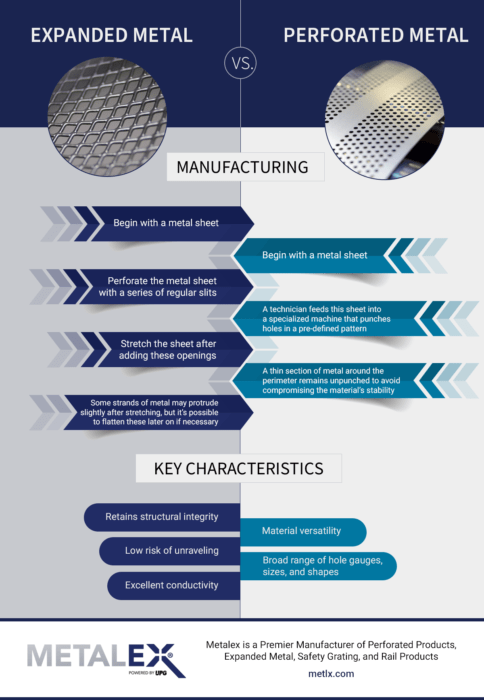

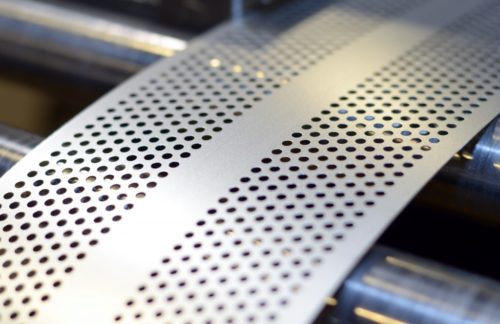 Metals have many inherent qualities, including strength, malleability, and durability, that make them ideal building components. Recently, architects and contractors have begun adopting new metal solutions to improve building performance, aesthetics, and safety. Two of the most common techniques, perforated and expanded metal, are particularly prized for their high strength, reliability, and flexibility, and their ability to provide high levels of security make them particularly beneficial for new or rehabbed buildings.
Metals have many inherent qualities, including strength, malleability, and durability, that make them ideal building components. Recently, architects and contractors have begun adopting new metal solutions to improve building performance, aesthetics, and safety. Two of the most common techniques, perforated and expanded metal, are particularly prized for their high strength, reliability, and flexibility, and their ability to provide high levels of security make them particularly beneficial for new or rehabbed buildings.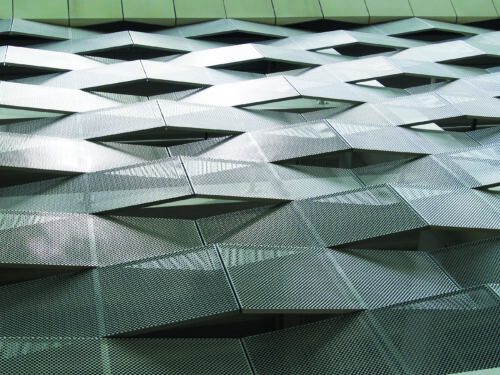 Security Mesh inside Walls, Ceilings, and Floors
Security Mesh inside Walls, Ceilings, and Floors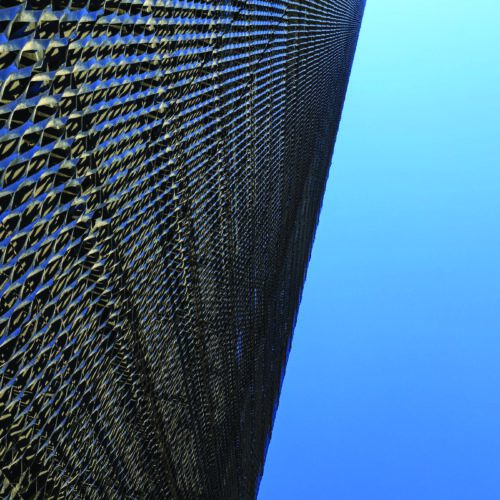 Making use of innovative new metal solutions allows for trade collaboration in the architectural industry. The large range of customization capabilities for perforated and expanded metals allows for a great deal of collaboration to take place between suppliers and clients. Because these metals can come in so many shapes, forms, and abilities, they offer limitless possibilities.
Making use of innovative new metal solutions allows for trade collaboration in the architectural industry. The large range of customization capabilities for perforated and expanded metals allows for a great deal of collaboration to take place between suppliers and clients. Because these metals can come in so many shapes, forms, and abilities, they offer limitless possibilities. Perforated sheets can be made from a variety of materials — stainless steel, coated steel, refractory metals, aluminum, copper alloys, zinc, nickel, and titanium, just to name a few — in order to work in conjunction with materials such as wood, natural stone, ceramic tiles, bricks, glass, and leather. This unique metal can also be manufactured in many different styles and patterns. Holes in the metal sheet can be round, diamond, hexagonal, or square, and are offered in various sizes. These holes can be arranged in a staggered or straight pattern.
Perforated sheets can be made from a variety of materials — stainless steel, coated steel, refractory metals, aluminum, copper alloys, zinc, nickel, and titanium, just to name a few — in order to work in conjunction with materials such as wood, natural stone, ceramic tiles, bricks, glass, and leather. This unique metal can also be manufactured in many different styles and patterns. Holes in the metal sheet can be round, diamond, hexagonal, or square, and are offered in various sizes. These holes can be arranged in a staggered or straight pattern.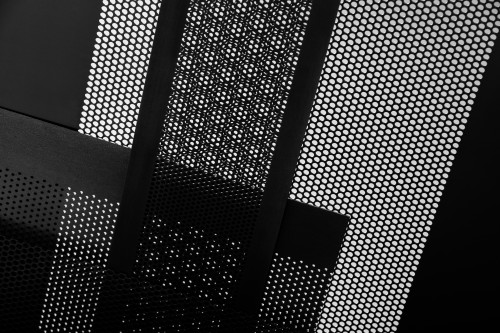 Speaker Grilles
Speaker Grilles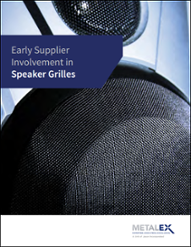
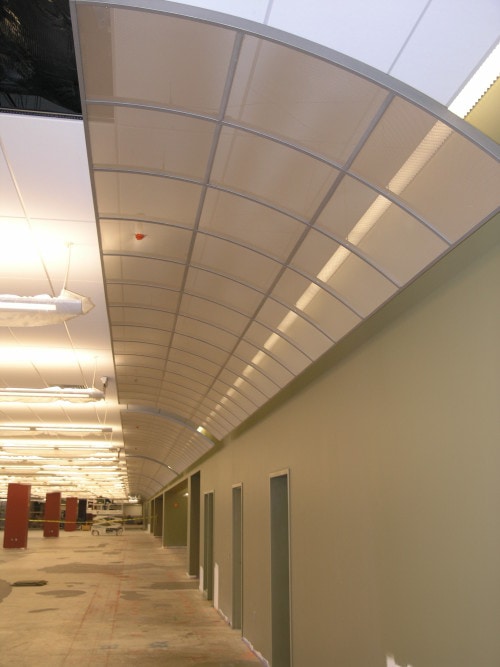 Perforated metal
Perforated metal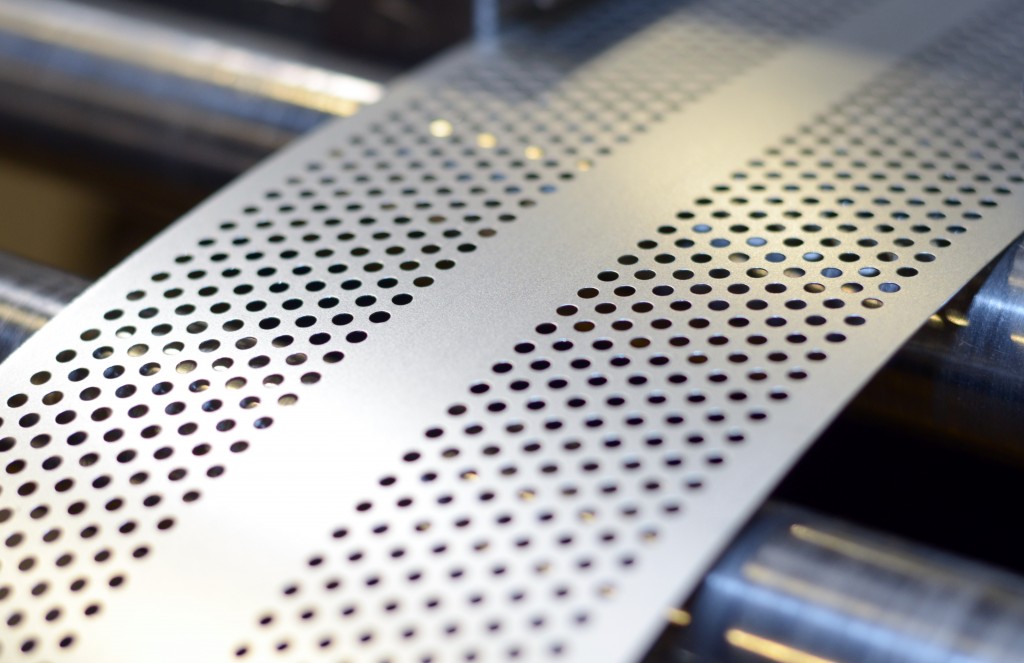 A simple sheet of
A simple sheet of 
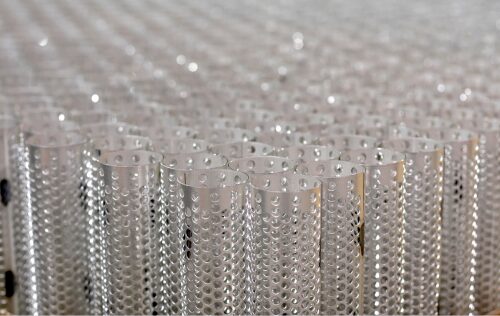
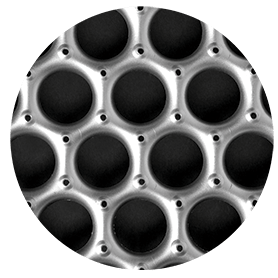 Round Holes. A round hole is the easiest and most economical shape to incorporate into perforated sheet metal, as the relative simplicity of machining a round piece results in low manufacturing costs. Round hole patterns are used in a variety of applications, including air-conditioning and heating systems and decorative finishes for architectural installations.
Round Holes. A round hole is the easiest and most economical shape to incorporate into perforated sheet metal, as the relative simplicity of machining a round piece results in low manufacturing costs. Round hole patterns are used in a variety of applications, including air-conditioning and heating systems and decorative finishes for architectural installations.